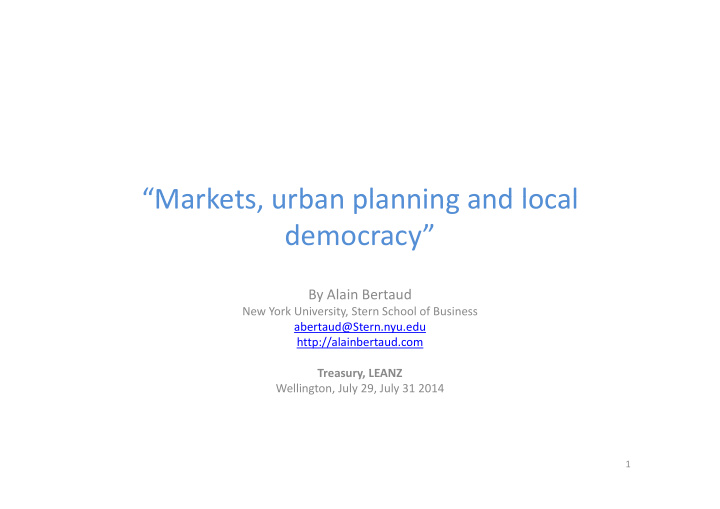



“Markets urban planning and local Markets, urban planning and local democracy” By Alain Bertaud New York University Stern School of Business New York University, Stern School of Business abertaud@Stern.nyu.edu http://alainbertaud.com T Treasury, LEANZ LEANZ Wellington, July 29, July 31 2014 1
Markets and urban planning have a complementary role • Markets M k t – Markets are efficient in allocating land between competing users – Markets are efficient in adjusting supply to demand – But markets have to rely on government planning to provide primary infrastructure, which in turn control land supply p y , pp y • Urban Planning – Planning is indispensable to draw a boundary between private and public land and public land – Planning is alone able to reserve arterial roads right of ways – Land use regulations have to be designed to avoid negative externalities – The financing and design of primary infrastructure depends on government planning g p g 2
Land markets allocate land consumption between users in different locations
Auckland population density profile Auckland population density profile 4
Urban Planning traditional role: insuring a steady supply of buildable land t d l f b ild bl l d New York Commissioners’ plan Chang’an during the Tang Dynasty Chang an during the Tang Dynasty 1811 1811 5
Traditional plans had simple objectives Traditional plans had simple objectives • separating in advance of development roads’ right of ways and public parks from private g y p p p lots • Increasing the supply of buildable land • Increasing the supply of buildable land • Increasing the speed of transport between different parts of the city 6
Urban planning mission creep Urban planning mission creep Using planning to achieve other objectives: Using planning to achieve other objectives: • Reducing commuting distances • Reducing CO2 emissions • Reducing CO2 emissions • Preserving agricultural land • Reducing obesity !!! These objectives are better achieved by using market tools: toll roads, gasoline or carbon tax, market tools: toll roads, gasoline or carbon tax, etc… 7
New dogmatic vaguely formulated fads often dominate urban planning This is not new, here is what Jane Jacobs was writing in the 1960s: g “… in the pseudoscience of city rebuilding and planning [ ] a plethora of subtle and planning, […] a plethora of subtle and complicated dogma have arisen on a foundation of nonsense.” f ” 8
“Smart growth”, “sustainable cities”, “livable cities” • Pretend to become “new and better” urban d b “ d b ” b development guiding principles • very vague non quantifiable objectives • Sound benign or even quite desirable Sound benign or even quite desirable • Substitute legitimate constraints (save energy) for real objectives (mobility affordability) for real objectives (mobility, affordability) • All of these “doctrines” favor containment and as a consequence an increase in densities and land prices
Planners have an important responsibility in maintaining mobility and housing affordability maintaining mobility and housing affordability. • They should use indicators to monitor changing mobility and affordability bilit d ff d bilit • They should take action when indicators show a d deterioration of mobility or/and affordability: f b l / d ff d b l – Manage congestion, – Plan new investments in infrastructure to increase commuting speed – Increase land supply (regulations and infrastructure l d l ( l d f investments) – Review land use regulations Review land use regulations – Shorten time required to process land development and building permits and building permits 10
Pl Planners are not the only ones trying to restrict t th l t i t t i t the supply of urban land 11
The origin of the increasing complexity of regulatory restrictions are not only found in planners hubris but have support among are not only found in planners’ hubris but have support among important segments of the voting population • NIMBY (not in my backyard), • BANANA (build absolutely nothing anywhere BANANA (build absolutely nothing anywhere near anyone) and • CAVE (citizens against virtually everything) CAVE ( i i i i ll hi ) The proliferation of these acronyms reflects a p y deep crisis in the ability of local democracy to implement anything implement anything 12
San Francisco has one of the most expensive real estate in the world but: • Voters last month (june 2014) approved a ballot initiative that means any development seeking to go beyond existing height limits (40ft to 84ft) will require the backing of voters, not just city q g j y officials. • The move follows a vote last year that overturned • The move follows a vote last year that overturned a ruling by city planners and rejected a proposed high end condo building that would have high ‐ end condo building that would have exceeded the standard waterfront height limit. 13
We need to redefine property rights a new balance between the rights of citizen to protest a new balance between the rights of citizen to protest and appeal government decisions and ability to implement civil works within a reasonable time implement civil works within a reasonable time framework • Redefining property rights to lower Redefining property rights to lower transaction costs, while preserving the right to appeal appeal • A new definition of Property rights (William A. Fischel : The Economics of Zoning Laws: A Property Rights Approach to American Land Property Rights Approach to American Land Use Controls ,1987) 14
The challenge is to be able to implement public works while protecting protecting individual liberties and individual property rights. If we cant, we will ll loose our liberties anyway liberties anyway. 15
Auckland densities profile
Auckland topography topography constrains land supply supply
Recommend
More recommend